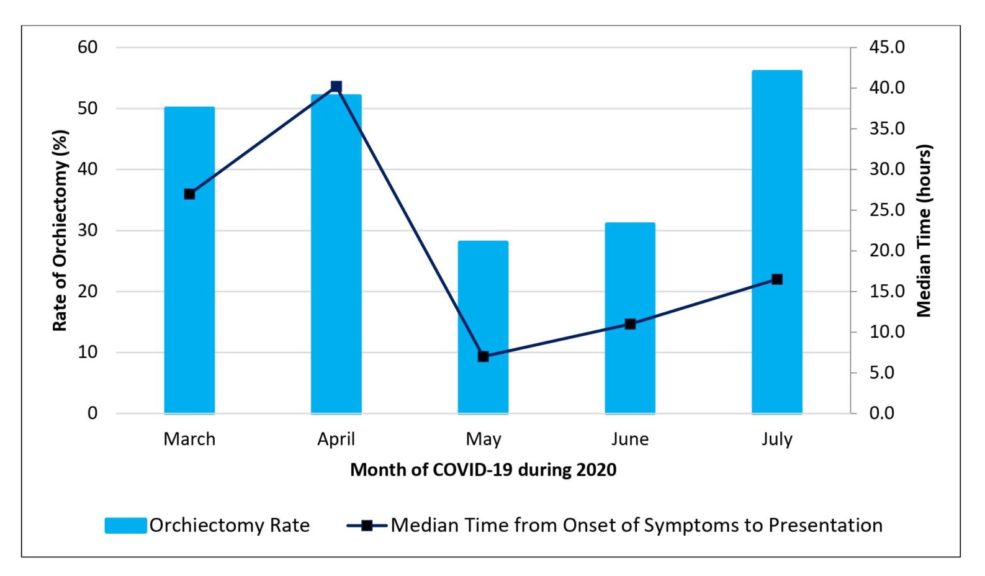CHOC’s pediatric urology team, in a partnership with UCI Health, has published the largest study of its kind on an emergency condition that afflicts young males, adding to the emerging body of data on how the COVID-19 pandemic has caused patients to delay seeking emergency treatment.
The CHOC/UCI-led study, recently published in the Journal of Pediatric Urology, also marks a first for the Western Pediatric Urology Consortium (WPUC), a group of several leading pediatric healthcare centers that CHOC was instrumental in founding in 2020.
“This study is a good example of CHOC leading the way and bringing together institutions to answer questions that haven’t been answered before,” says Carol Davis-Dao, PhD, a clinical epidemiologist in CHOC’s Department of Pediatric Urology who has a joint appointment in the UC Irvine Department of Urology.
Dr. Davis-Dao leads urology research efforts at CHOC to provide patients and their families with the most current, evidence-based diagnoses and treatments.
The lead author of “A Multicenter Study of Acute Testicular Torsion in the Time of COVID-10,” Dr. Sarah Holzman, a research fellow at UCI-CHOC, says the research paper is the only multicenter urology study and the largest one related to torsion and COVID-19. Most importantly, she adds, it’s the only study that shows patients were delaying presenting to the Emergency Department for testicular torsion.
The study’s key finding: Patients significantly delayed seeking treatment in the Emergency Department following the onset of symptoms of a testicular torsion during the early months of the pandemic, and, as a result, more of them had to have a testicle removed compared to patients with the same condition who sought care before the pandemic.
“This is the largest study of testicular torsion during COVID-19 and the first to show a significantly longer time from symptom onset to presentation (in the Emergency Department),” the paper states.
“Low baseline awareness of torsion may contribute to delays in care that were present even before the pandemic, making patients and their families less likely to present for emergency care during the pandemic when there is concern for exposure to COVID-19.”
Also participating as authors of the study were CHOC pediatric urologists Dr. Heidi Stephany, Dr. Kai-wen Chuang, Dr. Elias Wehbi, and Dr. Antoine Khoury, chief of pediatric urology at both CHOC and UC Irvine Medical Center.
Testicular torsion occurs when the spermatic cord that supplies blood to the testicle twists, cutting off the testicle’s blood supply. It presents as acute and severe scrotal pain that quickly worsens, as well as nausea and vomiting.

It’s a relatively rare surgical emergency, with an incidence rate of around 4 per 100,000 males per year in the United States. It most frequently occurs in males between the ages of 10 and 19, with one peak in the neonatal period and the second peak around puberty.
Surgery is required for all patients with testicular torsion.
When torsion is caught early — typically within the first six hours — a detorsion orchiopexy can be performed. In the detorsion surgery, the spermatic cord is untwisted and the blood flow returns to the testicle. The surgeon then secures the testis to the inner scrotum so it can never twist again. However, if patients delay coming to the hospital and the testicle does not have blood supply for several hours, the testicle may have to be removed in a procedure called an orchiectomy.
The CHOC-UCI led study involved a total of 221 patients enrolled at one of seven hospitals in the WPUC (CHOC, Children’s Hospital Los Angeles, Seattle Children’s, UC San Francisco, UCLA, UC San Diego and Western University in Ontario, Canada).
A total of 84 patients with testicular torsion, ages 2 months to 18 years, made up the first cohort. They were studied from March 2020 through July 2020.
The second cohort totaled 137 patients who were treated from January 2019 through February 2020.
The median time it took patients in the COVID-19 cohort to show up at the Emergency Department from the onset of symptoms was 17.9 hours, the study found. This compares to 7.5 hours for patients in the pre-pandemic cohort.
A total of 42 percent of patients in the COVID-19 cohort underwent an orchiectomy (removal of the twisted testicle), compared to 29 percent in the pre-pandemic population.

Other studies have shown that COVID-19 has caused people to delay Emergency Department treatment, including one that examined acute appendicitis from the New York metropolitan region and another similar study in Virginia.
During the last week of June 2020, 41 percent of U.S. adults admitted to avoiding medical care because of COVID-19 exposure concerns and 12 percent avoided urgent or emergent care, according to the Morbidity and Mortality Weekly Report, an epidemiological digest for the United States published by the Centers for Disease Control and Prevention.
Drs. Holzman and Davis-Dao say they plan to continue the study as the pandemic progresses.
Read more about CHOC’s Department of Urology.
COVID-19 vaccine guide: Information to share with patients, families




